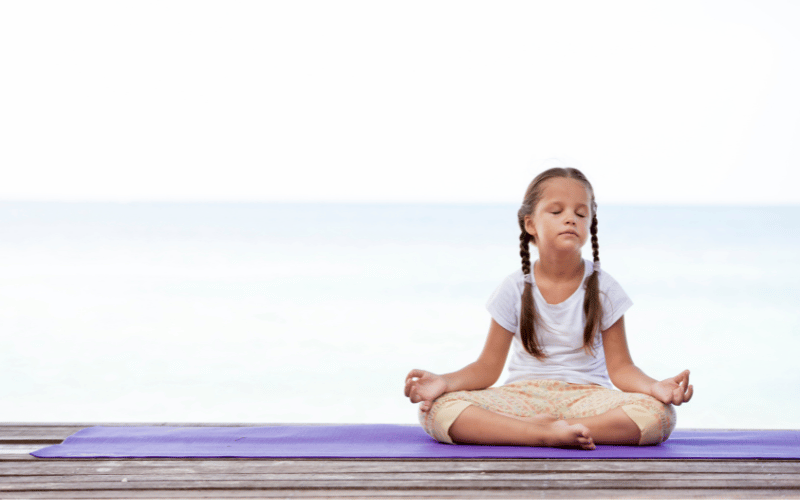In today’s fast-paced world, it’s more important than ever to help our children develop essential skills to stay grounded and focused. One such skill is meditation, which can provide numerous benefits to their mental, emotional, and physical well-being. In this extensive guide, we will explore the various techniques and approaches to teaching your child to meditate, as well as answer some common questions parents may have about the process.

The Importance of Meditation for Children
Meditation is not just for adults; it offers numerous benefits for children as well. Some of the key advantages of teaching your child to meditate include:
Improved Focus and Concentration
Meditation helps children develop their attention span and ability to concentrate, which can translate to better performance in school and other activities.
Enhanced Emotional Regulation
Through meditation, children learn to recognize and manage their emotions, leading to improved emotional intelligence and resilience.
Reduced Stress and Anxiety
Regular meditation can help children cope with stress and anxiety, promoting a sense of calm and well-being.
Better Sleep Quality
Meditation has been linked to improved sleep quality, which is crucial for a child’s overall health and development.
Types of Meditation Techniques for Children
When teaching your child to meditate, it’s essential to choose the right technique that suits their age, interests, and abilities. Some popular meditation styles for children include:
1. Mindfulness Meditation
This technique involves paying attention to the present moment without judgment. Children can practice mindfulness by focusing on their breathing, sounds, or sensations in their body. Guided mindfulness exercises or apps can be a helpful tool to get started with this practice.
2. Loving-Kindness Meditation (Metta)
In this form of meditation, children are encouraged to generate feelings of love and compassion towards themselves and others. They can start by visualizing someone they care about, then gradually extend these positive emotions to others, including acquaintances and even those they may not get along with.
3. Visualization Meditation
This technique involves creating mental images of calming, peaceful scenes or situations. For children, this could include imagining a serene beach, a magical forest, or even a favorite fictional character. Visualization can help children relax, reduce anxiety, and increase their creative imagination.
4. Body Scan Meditation
Body scan meditation involves focusing attention on different parts of the body, promoting relaxation and self-awareness. Children can be guided through this process by an adult, starting with their toes and moving up to their head, noticing any sensations or tension along the way.
5. Mantra Meditation
In mantra meditation, children repeat a word or phrase, such as “peace” or “I am calm,” either silently or aloud. This repetition helps to focus the mind and can have a calming effect.
Creating a Meditation Routine for Your Child
To ensure that meditation becomes a regular habit for your child, consider the following tips:
Choose a Consistent Time and Place
Establish a designated meditation space and a consistent time of day to practice. This could be in the morning before school, after homework, or before bedtime.
Make It Age-Appropriate
Modify the meditation techniques to suit your child’s age and attention span. For younger children, start with shorter sessions (2-5 minutes), gradually increasing the duration as they become more comfortable and focused.
Lead by Example
Children learn best by observing their parents or caregivers. Practice meditation yourself and share your experiences to encourage and motivate them.
Keep It Fun and Engaging
Incorporate playful elements, such as using meditation apps or guided stories, to make the practice enjoyable and interesting for your child.
Commonly Asked Questions About Teaching Children to Meditate
Here are some frequently asked questions regarding teaching meditation to children:
1. What is the best age to start teaching meditation to a child?
There is no specific age to start teaching meditation, as it can be adapted to suit children of different ages. However, introducing simple mindfulness practices as early as 3-4 years old can be beneficial for developing self-awareness and emotional regulation.
2. How can I help my child stay focused during meditation?
Patience and gentle guidance are essential when helping children stay focused. Encourage them to return their attention to their breath or chosen focus point whenever their mind wanders. Over time, they will become more skilled at maintaining focus.
3. What if my child doesn’t seem interested in meditation?
It’s essential to be patient and avoid forcing your child to meditate. Instead, try different techniques, engage in meditation-related activities, or share your experiences to pique their interest. Remember, meditation should be a positive and enjoyable experience.
4. Can meditation help my child with ADHD or other learning difficulties?
Yes, research suggests that meditation can be beneficial for children with ADHD or other learning difficulties by improving focus, attention, and self-regulation. However, it’s essential to work closely with your child’s healthcare provider and consider individual needs when introducing meditation as a complementary strategy.
5. How can I measure my child’s progress with meditation?
Measuring progress in meditation can be subjective, as it is a personal experience. However, you can look for signs such as increased focus, better emotional regulation, and reduced stress or anxiety. Additionally, engage in open conversations with your child about their experiences and feelings related to meditation.
Conclusion: Embracing the Power of Meditation for Your Child
Teaching your child to meditate can be a transformative experience, providing them with essential tools to navigate life’s challenges with greater ease and resilience. By choosing the right techniques, creating a consistent routine, and offering support and encouragement, you can help your child reap the numerous benefits of meditation. Remember to be patient and adaptable, allowing your child to develop their meditation practice at their own pace and in their unique way.